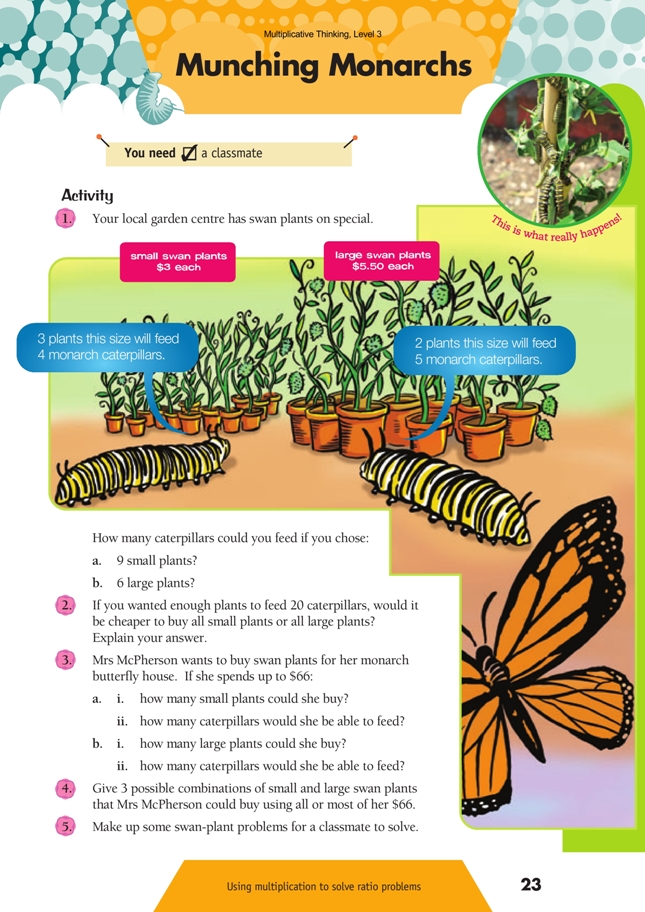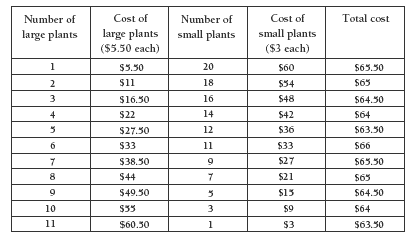This is a level 4 number activity from the Figure It Out series. It relates to Stage 7 of the Number Framework.
A PDF of the student activity is included.
Click on the image to enlarge it. Click again to close. Download PDF (708 KB)
use multiplication to solve simple ratio problems
Number Framework Links
Use this activity to help your students consolidate and apply advanced multiplicative part–whole strategies (stage 7) in the domain of proportions and ratios.
A classmate
In this activity, students use multiplication to solve ratio problems. It would suit a guided teaching session or could be used as an independent activity for a group. To work independently, students will need a reasonable range of multiplicative strategies, a good recall of multiplication basic facts, and the ability to look carefully at a question to work out what they need to do.
For question 1, some students may have difficulty with the idea of ratios and how they can use the information on the signs to solve the problem. If so, they may find it a help to use a double number line or a table to show how the number of caterpillars that can be fed increases with each group of swan plants bought.
This table shows similar information, but for more plants and caterpillars and for both grades of plant:
Encourage the students to use proportional strategies by asking If you know that it takes 3 small swan plants to feed 4 caterpillars, can you use that information to work out how many caterpillars could feed on 9 small plants? Record this as 3:4 = 9:. Expect the students to use multiplication or equivalent fractions to work out that a ratio of 9:12 is the same as 3:4. Similarly, for the large swan plants, record: 2:5 = 6:.
The double number lines and tables can be extended for question 2 until each shows how many swan plants are needed for 20 caterpillars.
To encourage the students to use proportional strategies, ask If you know that it takes 3 small swan plants to feed 4 caterpillars, can you use that information to work out how many small swan plants are needed for 20 caterpillars? Record this as 3:4 = :20. Expect the students to use multiplication or equivalent fractions to work out that a ratio of 15:20 is the same as 3:4. Similarly, for the large swan plants, record: 2:5 = :20.
Alternatively, the students could first work out how many plants of each size would feed 20 caterpillars by dividing the 20 caterpillars into smaller groups that suit each type of swan plant (small plants: 20 caterpillars ÷ groups of 4 = 5 groups, 5 groups of 3 plants = 15 plants; large plants: 20 caterpillars ÷ groups of 5 = 4 groups, 4 groups of 2 plants = 8 plants) and then working out how much those plants would cost (small plants: 15 plants at $3 each = $45, large plants: 8 plants at $5.50 each = $44).
In question 3, some students may have difficulty working out how many caterpillars Mrs McPherson could feed with 22 small plants because 22 does not divide evenly into groups of 3 swan plants. Encourage them to estimate the number of caterpillars by asking questions such as:
• What’s the nearest multiple of 3 to 22 that you could use? (21)
• How many caterpillars would 21 small plants feed? Record: 3:4 = 21: (28)
• How many extra plants does Mrs McPherson have? (1)
• How many caterpillars would you estimate 1 small plant will feed if you know that 3 plants will feed 4 caterpillars? (1 of a caterpillar, but since you can’t have a third of a caterpillar, Mrs McPherson will only be able to have 1 caterpillar for that plant, meaning that she can raise 29 caterpillars on 22 plants.)
Some students may have difficulty multiplying and dividing by $5.50 or 5.5 in question 4. If so, encourage them to make the link between 5.5 and 11, which is easier to use in calculations. Alternatively, they could reverse the problem and use multiplication to build up to $66 using facts they know, such as 10 x 5.5 = 55.
For question 5, remind the students that they need to be able to solve and explain their own problems. This will help ensure that the numbers they choose work well with mental strategies.
After the activity
Encourage reflective thinking and the discussion of generalisations by asking questions such as:
• Which problems did you find hardest? Share how you solved them.
• Was there a strategy that someone else used that you could use another time? What is it about
the problem that would remind you that this would be a good strategy to try?
• What can you tell me about ratios? How does knowing about ratios help with this activity?
The photograph on the student page indicates that the mathematics on this page does not accurately reflect the reality of the rate at which monarch caterpillars eat (or destroy!) swan plants. The students could do some Internet research on this topic.
Answers to Activity
1. a. 12 caterpillars. (3:4 = 9:12. 9 small plants ÷ groups of 3 = 3 groups,
3 groups x 4 caterpillars = 12 caterpillars)
b. 15 caterpillars. (2:5 = 6:15. 6 large plants ÷ groups of 2 = 3 groups,
3 groups x 5 caterpillars = 15 caterpillars)
2. Buying all large plants would be the cheaper option ($44 compared with $45 for small plants). 20 caterpillars would need 15 small plants (3:4 = 15:20), 15 small plants at $3 cost $45. 20 caterpillars would need 8 large plants (2:5 = 8:20), 8 large plants at $5.50 cost $44.
3. a. i. 22 small plants. ($66 ÷ $3 = 22)
ii. About 29 caterpillars. (21 small plants would feed 28 caterpillars because
3:4 = 21:28. The 22nd plant would feed 1 caterpillars [ of 4 = 1 ],
so the extra plant would be enough for 1 extra caterpillar, but not for 2.)
b. i. 12 large plants. ($66 ÷ $5.50 = 12. A possible strategy for this is to solve
[66 ÷ 11] x 2 = 6 x 2 = 12. $5.50 x 2 = $11, so this is easier to calculate. Alternatively, you could reverse the problem and use multiplication: 10 x $5.50 = $55, $66 – $55 = $11, 2 x $5.50 = $11. 10 + 2 = 12 plants)
ii. 30 caterpillars. (2:5 = 12:30)
4. Answers will vary. To spend all her $66, Mrs McPherson would have to buy 6 large plants and 11 small ones (6 x $5.50) + (11 x $3) = $33 + $33 = $66. There are 11 possible options:
5. Practical activity



